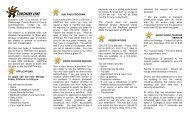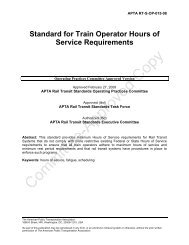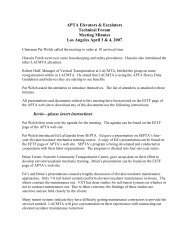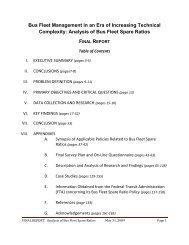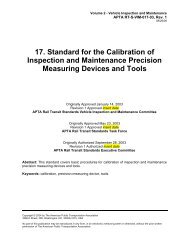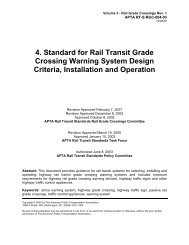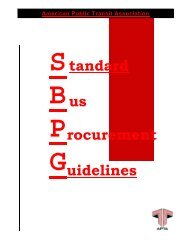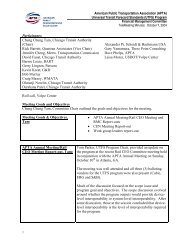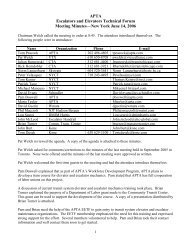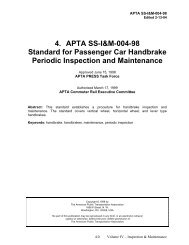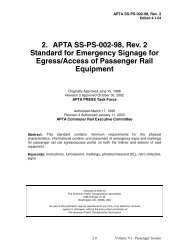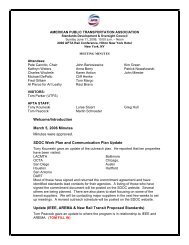Table of Contents - APTAStandards.com
Table of Contents - APTAStandards.com
Table of Contents - APTAStandards.com
Create successful ePaper yourself
Turn your PDF publications into a flip-book with our unique Google optimized e-Paper software.
Though the majority <strong>of</strong> the messages and related data elements have been designed for<br />
financial transaction interchange, they share some <strong>com</strong>monalities with public transit<br />
electronic fare payment transactions.<br />
4.1.2 Applicability to UTFS Effort<br />
ISO/IEC 8583 lacks transit industry specific data elements and message types that need<br />
to be defined by APTA. The addition <strong>of</strong> this new information requires their submission<br />
to ISO/IEC, the international standards body that controls and maintains the changes to<br />
the standard. The timeline for an effort such as this is largely unknown, but estimated<br />
to be lengthy. For all the benefits <strong>of</strong>fered, this standard may serve as a model for<br />
UTFS<br />
WP4 efforts.<br />
Of all the standards and specifications analyzed, ISO/IEC 8583 is the most established<br />
and widely implemented standard throughout the world. Financial data exchange<br />
<strong>of</strong><br />
all magnetic stripe based credit card transactions follows this standard. Following the<br />
advancements in the card technologies, ISO/IEC 8583 has been updated to<br />
ac<strong>com</strong>modate mostly contact based smart card transactions. Its financial industry focus<br />
led<br />
to the presence <strong>of</strong> a variety <strong>of</strong> clearing and settlement transactions exchanged<br />
between entities. Though it is mostly used for on-line real time “request-response”<br />
type<br />
transactions, the standard provides details for batch<br />
and file transfer mechanisms.<br />
4.1.3 Common Message Structure<br />
ISO/IEC 8583 provides a <strong>com</strong>mon message structure, which defines three main sections<br />
for<br />
each message as illustrated in Exhibit 4.1-1.<br />
Exhibit 4.1-1 Common Message Structure<br />
Message Type Message Bitmap(s) Data Elements<br />
Message type consists <strong>of</strong> two elements, a version number and a message type identifier.<br />
The version number is allocated to indicate the version <strong>of</strong> the ISO/IEC 8583 standard<br />
followed by the interchange. The message type identifier is a three digit numeric field<br />
identifying the following:<br />
• Message class<br />
• Message function<br />
• Transaction originator<br />
Message class identifies whether it is a financial, administrative, or network<br />
management type <strong>of</strong> a message. Message function specifies if it is a request, response,<br />
notification or advice. The transaction originator digit identifies the originator <strong>of</strong> the<br />
message (e.g., issuer or acquirer).<br />
Page 14



